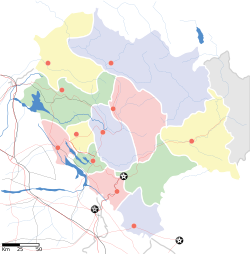Nurpur, Himachal Pradesh
| Nurpur Kangra | |
|---|---|
| City | |
| Location in Distt. Kangra, Himachal Pradesh, India | |
| Coordinates: 32°18′N 75°54′E / 32.3°N 75.9°ECoordinates: 32°18′N 75°54′E / 32.3°N 75.9°E | |
| Country |
|
| State | Himachal Pradesh |
| District | Kangra |
| Elevation | 643 m (2,110 ft) |
| Population (2005) | |
| • Total | 9,066(17th) |
| Languages | |
| • Official | Hindi |
| Time zone | IST (UTC+5:30) |
Nurpur is a city and a municipal council in Kangra district in the Indian state of Himachal Pradesh. It was formerly part of the Nurpur State ruled by the Pathania clan of Tomara Rajputs, since the 11th century AD. The capital of the kingdom was at Pathankot formerly known as Paithan, now in Punjab.
Nurpur is located at 32°18′N 75°54′E / 32.3°N 75.9°E. It has an average elevation of 643 metres (2109 feet).
As of 2001[update], according to the India census, Nurpur had a population of 9045. Men constitute 52% of the population and women 48%. Nurpur has an average literacy rate of 78%, higher than the national average of 59.5%: male literacy is 81%, and female literacy is 75%. In Nurpur, 11% of the population is under 6 years of age.
Nurpur was founded in the 11th century by Raja Jhet Pal, who was the younger brother of the ruler of Delhi. It reached its peak during the reign of Raja Basu, from 1580 to 1613, who built an impressive fort that can still be seen today.
Earlier Nurpur was known with the name of Dhameri. This was changed when it was visited by Queen Nur Jehan, the wife of the Mughal emperor Nuruddin Salim Jahangir, who ruled between 1569–1627. According to the local legend, the queen was so impressed by beauty and richness of town that she decided to stay there for the rest of her life. This decision made the local administration worry since the Mughal empire at that time were expanding across India and the local leaders of Dhameri did not want their peaceful town to be a central point for Mughal domination and influenced by external politics. So, to deal with this without offending the queen and suffering the wrath of the Mughal empire, they devised a simple but effective plan. They advised the queen that staying in their town for a long period of time could spoil her great beauty, and that there is also a fictitious local disease in town that might afflict her. This terrified the queen so much that she hurriedly left. So in 1622, during the reign of Raja Jagat Singh Pathania, the name of the town was changed to Nurpur in honor of the Mughal queen who fell in love with the beauty of the place. Before 1947, Nurpur was a princely state ruled by the Pathania clan of Rajputs. The Pathania Clan (or Tomar / Tanwar clan of Chandravanshi Rajputs) had ruled here for more than eight centuries.
...
Wikipedia


